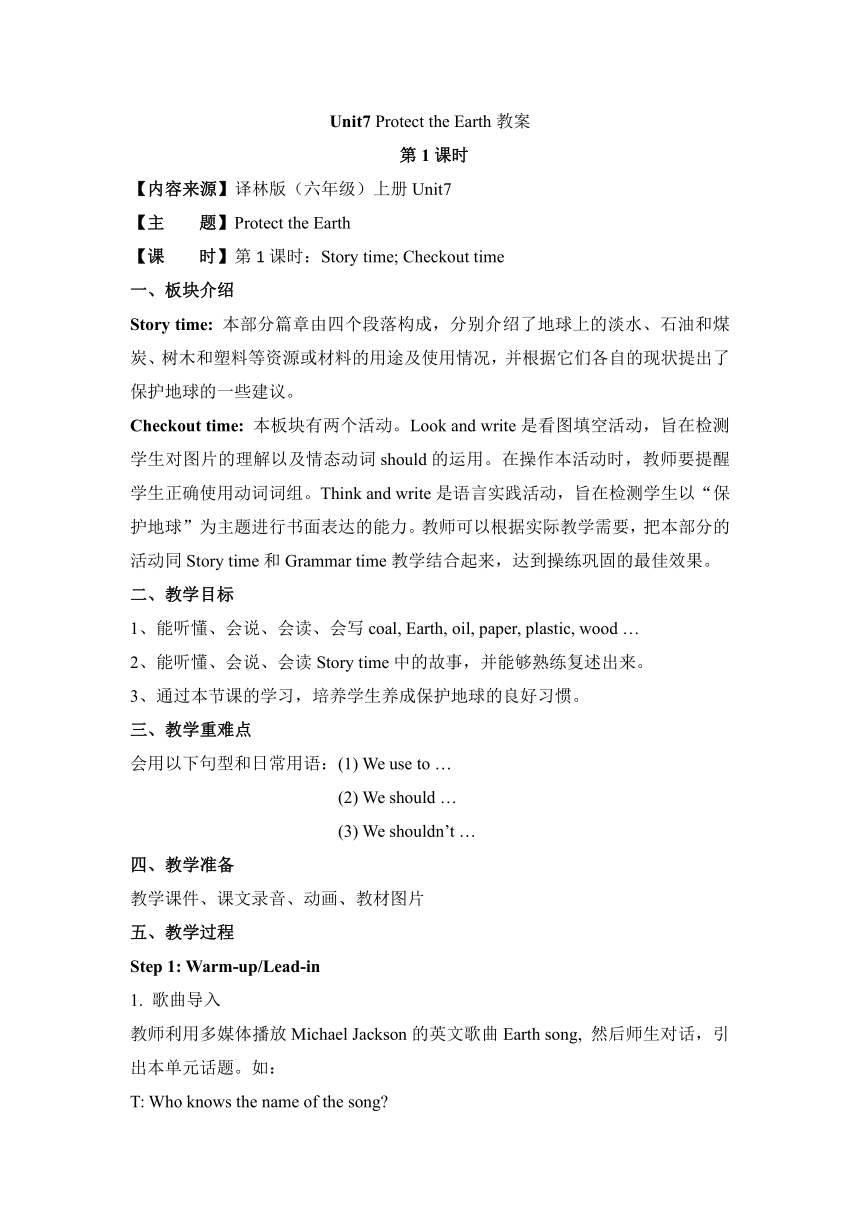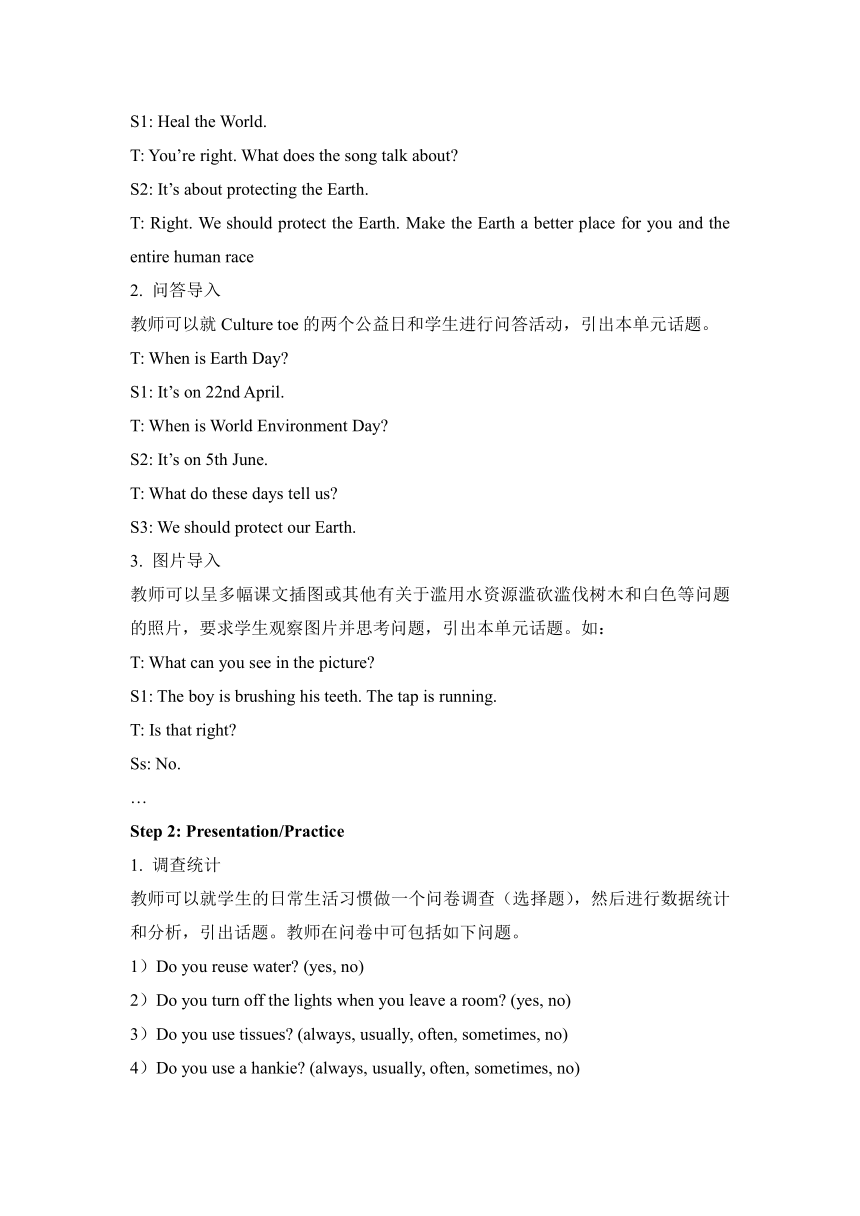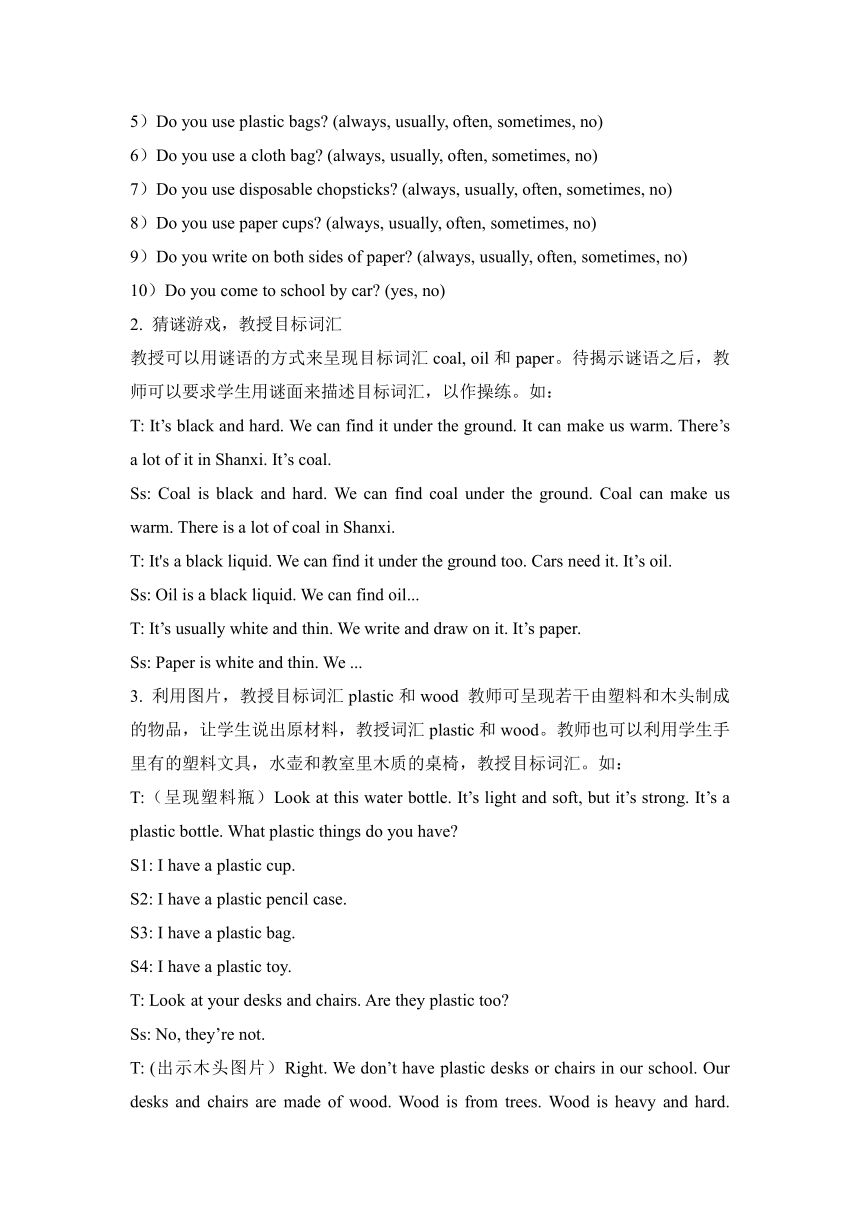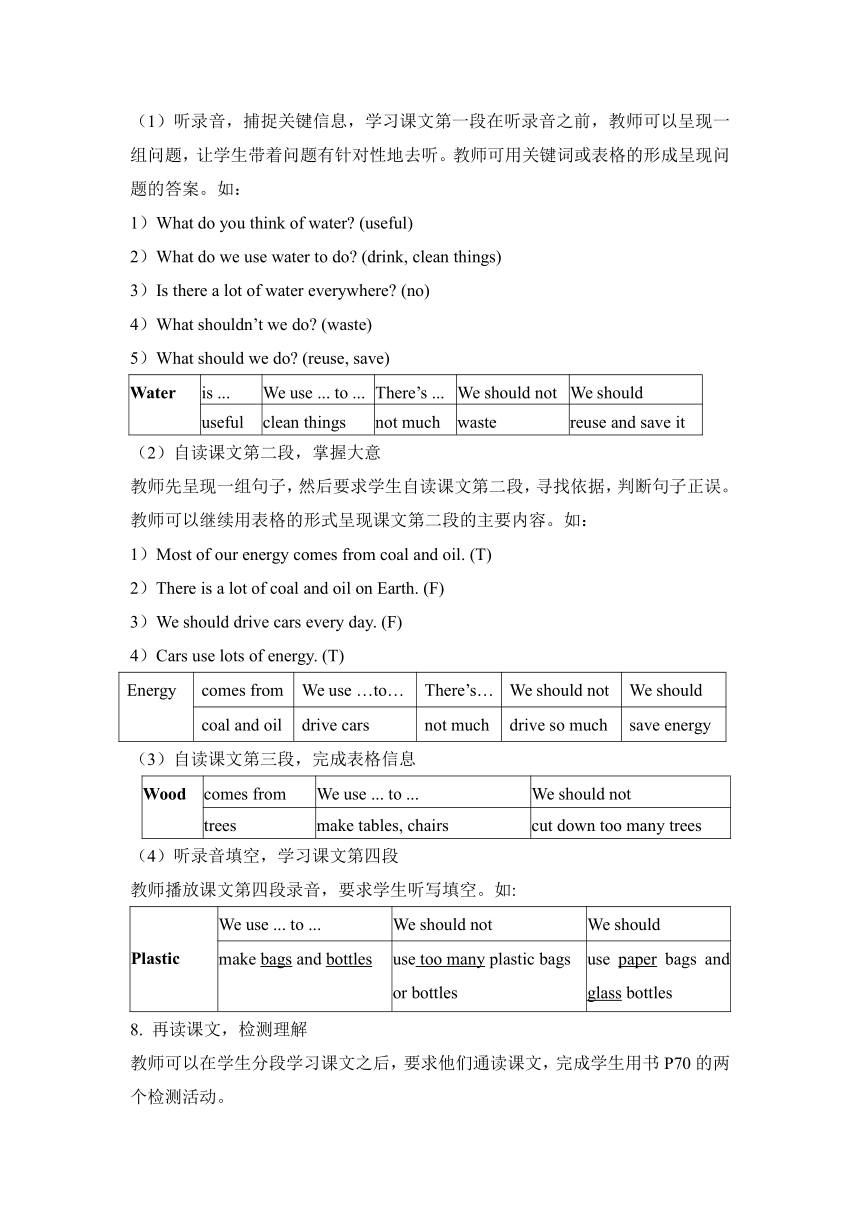Unit7 Protect the Earth教案(共4个课时)
文档属性
| 名称 | Unit7 Protect the Earth教案(共4个课时) |  | |
| 格式 | doc | ||
| 文件大小 | 145.6KB | ||
| 资源类型 | 教案 | ||
| 版本资源 | 牛津译林版 | ||
| 科目 | 英语 | ||
| 更新时间 | 2021-07-19 10:29:12 | ||
图片预览





文档简介
Unit7 Protect the Earth教案
第1课时
【内容来源】译林版(六年级)上册Unit7
【主 题】Protect the Earth
【课 时】第1课时:Story time; Checkout time
一、板块介绍
Story time: 本部分篇章由四个段落构成,分别介绍了地球上的淡水、石油和煤炭、树木和塑料等资源或材料的用途及使用情况,并根据它们各自的现状提出了保护地球的一些建议。
Checkout time: 本板块有两个活动。Look and write是看图填空活动,旨在检测学生对图片的理解以及情态动词should的运用。在操作本活动时,教师要提醒学生正确使用动词词组。Think and write是语言实践活动,旨在检测学生以“保护地球”为主题进行书面表达的能力。教师可以根据实际教学需要,把本部分的活动同Story time和Grammar time教学结合起来,达到操练巩固的最佳效果。
二、教学目标
1、能听懂、会说、会读、会写coal, Earth, oil, paper, plastic, wood …
2、能听懂、会说、会读Story time中的故事,并能够熟练复述出来。
3、通过本节课的学习,培养学生养成保护地球的良好习惯。
三、教学重难点
会用以下句型和日常用语:(1) We use to …
(2) We should …
(3) We shouldn’t …
四、教学准备
教学课件、课文录音、动画、教材图片
五、教学过程
Step 1: Warm-up/Lead-in
1. 歌曲导入
教师利用多媒体播放Michael Jackson的英文歌曲Earth song, 然后师生对话,引出本单元话题。如:
T: Who knows the name of the song?
S1: Heal the World.
T: You’re right. What does the song talk about?
S2: It’s about protecting the Earth.
T: Right. We should protect the Earth. Make the Earth a better place for you and the entire human race
2. 问答导入
教师可以就Culture toe的两个公益日和学生进行问答活动,引出本单元话题。
T: When is Earth Day?
S1: It’s on 22nd April.
T: When is World Environment Day?
S2: It’s on 5th June.
T: What do these days tell us?
S3: We should protect our Earth.
3. 图片导入
教师可以呈多幅课文插图或其他有关于滥用水资源滥砍滥伐树木和白色等问题的照片,要求学生观察图片并思考问题,引出本单元话题。如:
T: What can you see in the picture?
S1: The boy is brushing his teeth. The tap is running.
T: Is that right?
Ss: No.
…
Step 2: Presentation/Practice
1. 调查统计
教师可以就学生的日常生活习惯做一个问卷调查(选择题),然后进行数据统计和分析,引出话题。教师在问卷中可包括如下问题。
1)Do you reuse water? (yes, no)
2)Do you turn off the lights when you leave a room? (yes, no)
3)Do you use tissues? (always, usually, often, sometimes, no)
4)Do you use a hankie? (always, usually, often, sometimes, no)
5)Do you use plastic bags? (always, usually, often, sometimes, no)
6)Do you use a cloth bag? (always, usually, often, sometimes, no)
7)Do you use disposable chopsticks? (always, usually, often, sometimes, no)
8)Do you use paper cups? (always, usually, often, sometimes, no)
9)Do you write on both sides of paper? (always, usually, often, sometimes, no)
10)Do you come to school by car? (yes, no)
2. 猜谜游戏,教授目标词汇
教授可以用谜语的方式来呈现目标词汇coal, oil和paper。待揭示谜语之后,教师可以要求学生用谜面来描述目标词汇,以作操练。如:
T: It’s black and hard. We can find it under the ground. It can make us warm. There’s a lot of it in Shanxi. It’s coal.
Ss: Coal is black and hard. We can find coal under the ground. Coal can make us warm. There is a lot of coal in Shanxi.
T: It's a black liquid. We can find it under the ground too. Cars need it. It’s oil.
Ss: Oil is a black liquid. We can find oil...
T: It’s usually white and thin. We write and draw on it. It’s paper.
Ss: Paper is white and thin. We ...
3. 利用图片,教授目标词汇plastic和wood 教师可呈现若干由塑料和木头制成的物品,让学生说出原材料,教授词汇plastic和wood。教师也可以利用学生手里有的塑料文具,水壶和教室里木质的桌椅,教授目标词汇。如:
T:(呈现塑料瓶)Look at this water bottle. It’s light and soft, but it’s strong. It’s a plastic bottle. What plastic things do you have?
S1: I have a plastic cup.
S2: I have a plastic pencil case.
S3: I have a plastic bag.
S4: I have a plastic toy.
T: Look at your desks and chairs. Are they plastic too?
Ss: No, they’re not.
T: (出示木头图片)Right. We don’t have plastic desks or chairs in our school. Our desks and chairs are made of wood. Wood is from trees. Wood is heavy and hard. Wood is strong too.
4. 利用图片,教授新句型
教师准备两组图片,一组是water, coal, oil, paper, plastic, wood原材料图片,一组是有关这些原材料应用的图片,然后用本单元重点句型use ... to ...表述两组图片的关系。教师也可以根据学生的接受能力拓展介绍glass, metal等词汇。如:
T: We use water to wash clothes/brush teeth/cook food.
We use coal to make electricity.
We use oil to make gas.
We use paper to make books.
We use plastic to make bags/bottles/toys.
We use wood to make desks/beds/boats.
We use metal to make cars/trains/ships.
We use glass to make bottles/windows.
5. 看图说话,操练目标词汇和新句型教师可将原材料和有关原材料用途的图片放在一起呈现,要求学生描述原材料的特性和用途。教师可以将学生分成若干小组,每个小组选择一组图片,以接龙的形式,一人一句,合作完成描述。最后,教师邀请小组代表单独完成表述任务。如:
S: Water has no colour or smell. You can find water in the rivers and lakes. We drink water. We use water to cook. We use water to wash the clothes and the dishes.
…
6. 整体呈现课文
教师播放课文录音或课文动画,整体呈现课文,让学生了解保护地球的四个方面。如:
T: How can we protect the Earth?
S1: We can save water.
S2: We can save energy.
S3: We can save trees.
S4: We should not use too much plastic.
7. 分段学习课文,完成信息表格
(1)听录音,捕捉关键信息,学习课文第一段在听录音之前,教师可以呈现一组问题,让学生带着问题有针对性地去听。教师可用关键词或表格的形成呈现问题的答案。如:
1)What do you think of water? (useful)
2)What do we use water to do? (drink, clean things)
3)Is there a lot of water everywhere? (no)
4)What shouldn’t we do? (waste)
5)What should we do? (reuse, save)
Water is ... We use ... to ... There’s ... We should not We should
useful clean things not much waste reuse and save it
(2)自读课文第二段,掌握大意
教师先呈现一组句子,然后要求学生自读课文第二段,寻找依据,判断句子正误。教师可以继续用表格的形式呈现课文第二段的主要内容。如:
1)Most of our energy comes from coal and oil. (T)
2)There is a lot of coal and oil on Earth. (F)
3)We should drive cars every day. (F)
4)Cars use lots of energy. (T)
Energy comes from We use …to… There’s… We should not We should
coal and oil drive cars not much drive so much save energy
(3)自读课文第三段,完成表格信息
Wood comes from We use ... to ... We should not
trees make tables, chairs cut down too many trees
(4)听录音填空,学习课文第四段
教师播放课文第四段录音,要求学生听写填空。如:
Plastic We use ... to ... We should not We should
make bags and bottles use too many plastic bags
or bottles use paper bags and glass bottles
8. 再读课文,检测理解
教师可以在学生分段学习课文之后,要求他们通读课文,完成学生用书P70的两个检测活动。
Step 3: Consolidation
1. 复述课文
教师要求学生根据板书的四个表格信息框架,复述课文。教师可安排学生以小组的形式完成此活动。最后,教师邀请若干学生在全班同学面前复述课文的某一段。
2. 猜谜游戏,巩固目标词汇
教师用谜语的形式描述目标词汇,让学生猜出单词。
3. 看图说话,巩固目标词汇和新句型
教师呈现单词图片,要求学生描述图片上原材料的特性和用途。说的越多越好。
4. 看图说句,巩固新句型
教师呈现两张图片,一张是原材料图片,一张是有关其用途的图片,要求学生用use ... to ... 造句。
5. 归纳总结,巩固课文内容
教师可以在黑板上写上单元标题Protect the Earth, 然后在其下面呈现两个副标题 We should和We should not。教师要求学生在两个副标题下面写短语,以归纳保护地球的做法,同时避免不当行为。教师可以在此活动基础上,安排学生完成学生用书P77 Checkout time的Think and write活动。
6. 连句成段
教师选取课文中的一段,将段内句子顺序打乱,呈现给学生。教师要求学生先大声朗读句子,再排序句子,反应最快的学生为胜。然后要求学生齐读或尝试复述整段文字,以此巩固课文内容。
7. 头脑风暴
教师先给出一条保护地球的建议,然后要求学生给出一个句子,或说明理由或补充具体做法。学生可以用课文中的内容,也可以运用课外知识。如:
T: To protect the Earth, we should save water.
S1: Water is important.
S2: Water is useful.
S3: We drink water every day.
S4: Trees and flowers need water.
S5: Water comes from the sea, the lakes and the rivers.
S6: We should reuse water.
S7: We should not waste water.
…
8. 制作海报
教师将学生分为四组,要求每组选取课文中有关保护地球的一个方面,设计一个 海报,倡导大家关心地球,保护地球。海报要包括图片或图画和文字。小组成员分工合作,共同完成海报,然后再向全班同学宣讲自己的海报。如:
Save trees Wood comes from trees.
We use wood to make a lot of things.
We should not cut down too many trees.
Trees can help keep the air clean.
We should plant more trees.
9. 介绍有关保护地球的标语 教师呈现一组有关保护地球的英文标语,师生共读,以总结单元主题。如:
1)Save the world, save our lives. 拯救地球,拯救我们自己。
2)We are the world. 我们即世界。
3)Save our world, save our future. 拯救环境,拯救未来。
4)Save energy, save our planet. 节约能源,拯救地球。
5)Play your role. 从我做起。
6)Love the Earth, love life. 爱地球,爱生命。
7)Think green. 树立绿色意识。
8)Be seen to be green. 低碳生活,从我做起。
9)Recycle the present, save the future. 现在回收,将来不愁。
Step 4: Summary
词汇:coal, Earth, oil, paper, plastic, wood.
句型:(1) We use ... to ...
(2)We should...
(3)We shouldn’t...
Step 5: Homework
听录音跟读课文Story time.
Story time:
True or false
参考答案
1T 2F 3F 4T 5F
Think and write
参考答案
1. water, reuse, waste
2. energy, drive
3. trees, trees
4. plastic, paper, glass
Checkout time:
Look and write
参考答案
1. smoke 2. litter 3. cut down too many trees 4. put rubbish 5. talk 6. use too many plastic bags
Think and write
参考答案
略
Unit7 第2课时
【内容来源】译林版(六年级)上册Unit7
【主 题】Protect the Earth
【课 时】第2课时:Grammar time; Fun time
一、板块介绍
Grammar time: 本板块归纳呈现了本单元的重点句型use…to…的用法以及情态动词should的肯定句和否定句。
Fun time: 这是一个“变废为宝”的手工活动。活动分为两个步骤,学生先用报纸、塑料袋和塑料瓶等废旧材料,制作储物盒、玩具等物品,然后再用句型reuse ... to make ...做介绍。教师可以安排学生课前准备一些废旧物品和材料,以备课上活动使用。在活动前,教师可以和学生一起先了解活动步骤和要求,然后安排学生分组活动,发挥想象力,用手里的废旧材料制作有用的东西。最后教师可邀请各小组展示自己的作品,并用句型reuse ... to make ... 做介绍。
二、教学目标
1. 能熟练运用use … to …句型结构。
2. 通过本节课的学习能够培养学生养成合理利用废旧材料,养成爱护地球家园的良好习惯。
三、教学重难点
灵活运用句型use … to …和reuse ... to make ...句型结构。
四、教学准备
教学课件,报纸、塑料袋和塑料瓶等废旧材料。
五、教学过程
Step 1: Warm-up/Lead-in
朗读句子,认知结构
教师安排学生阅读第一个表格,然后要求个别学生或者全体学生朗读表格中呈现的句子。
Step 2: Presentation/Practice
2 头脑风暴,组词比赛
教师给出关键词,如water, wood等,然后要求学生用use… to…进行造句比赛。教师可以将学生分为若干小组,造句最多的那一组获胜。如:
Sl: We use water to water trees.
S2: We use water to clean the desks.
S3: We use water to wash the dishes.
S4: We use water to brush our teeth.
S5: We use water to wash the clothes.
S6: We use water to clean our cars.
S7: We use water to water flowers.
S8: We use water to cook food.
…
3. 发散思维,组合游戏
教师给出A、B、C三组词汇,内容分别为人称代词或人名,原料或用具名词和动词或动词词组。然后教师要求学生用use ... to ...句型,选取A、B、C三组中的词汇或短语,组成通顺的句子。如:
A
B
C
S1: They use pens to write.
S2: We use crayons to draw pictures.
S3: He uses chopsticks to eat.
S4: Helen uses paper to make a box.
S5: You use a computer to play games.
S6: Mike uses a cup to drink.
…
4. 朗读句子,认知结构
教师安排学生阅读第二个表格,复习情态动词should的用法。教师也可以和学生一起复习五年级下册Unit 4 (Seeing the doctor)中有关should的句子。
Step 3: Consolidation
看图写话
教师安排学生完成学生用书P76 Checkout time中的Look and write, 让他们根据图片内容,填写单词或词组,完成句子。教师也可以提供更多有关个人在公共场所的行为图片或有关破坏环境的图片,要求学生用should和should not判断和纠正不当行为。
2. Fun time:
1. 讲解活动步骤
教师和学生一起看图,理解指令和活动步骤。
2. 学生分组活动
教师安排学生四人一组,要求他们集中自己手里的材料,先讨论能做什么、如何做、如何分工等问题,然后再开始制作。教师可以鼓励学生发挥想象力和创造力,共同协作,完成作品。
3. 作品展示
教师邀请各小组展示并介绍自己的作品,可以由一人介绍,也可以由小组多个成员合力介绍。学生的语言表述可适当发挥拓展,也可以介绍制作步骤和所需材料。
Step 4: Summary
句型:(1) We use …
(2) We should …
(3)We shouldn’t …
Step 5: Homework
请学生用We should/shouldn’t …造句。
Unit7第3课时
【内容来源】译林版(六年级)上册Unit7
【主 题】Protect the Earth
【课 时】第3课时:Sound time; Culture time
一、板块介绍
Sound time: 本板块呈现了字母组合oo在单词 中的发音,即/u:/。对于这部分出现的绕口令,教师要鼓励学生反复朗读,在听听、读读、拍拍节奏等活动中感受字母组合oo在单词中的读音。
Culture time: 本模块呈现了两个有关环境保护的公益日。
Earth Day is on 22nd April.
地球日为4月22日。
World Environment Day is on 5th June.
世界环境日为6月5日。
We should love and protect our Earth.
我们应当热爱并保护地球。
二、教学目标
能够熟练读出字母组合oo在单词 中的发音,即/u:/。
三、教学重难点
四、教学准备
教学课件,教学音频。
五、教学过程
Step 1: Warm-up/Lead-in
Make a show: 结合上节课的家庭作业,请学生展示自己用should造的句子。并请学生分小组展示出来,教师并鼓励学生的积极参与。提高学生的团队意思和积极参加班级活动的意识。
Step 2: Presentation/Practice
Sound time:
1. 录音跟读
教师播放录音,要求学生跟读单词和歌谣,模仿语音语调。
2. 示范朗读
教师可以示范朗读单词,也可以请发音较好的学生做示范。教师要提醒学生边听边体会,边听边模仿。
3. 举一反三
教师要求学生找出已学过的含有字母组合oo且读音为/u:/的单词,如noodles, too, moon等。
4. 教师迁移运用
鼓励学生读出没有学过的含有字母组合oo且读音为/u:/的单词,如choose, noon, goose等。教师也可鼓励学生用含有字母组合oo的单词创编新的绕口令。
Culture time:
文化知识
每年的月22日是世界地球日,它旨在唤起人类爱护地球、保护家园的意识,促进资源开发与环境保护的协调发展,进而改善地球的整体环境。
每年的6月5日是世界环境日,它是联合国促进全球环境意识、提高政府对环境问题的注意并采取行动的主要媒介之一。联合国环境规划署每年6月5日选择一个成员国举行“世界环境日”纪念活动,发表《环境现状的年度报告书》及表彰“全球500佳”,并根据当年的世界主要环境问题及环境热点,有针对性地制定每年的“世界环境日”主题。
Step 3: Summary
Every day I go to school.
I think it’s really cool!
We have fun in the classroom.
Every morning and afternoon!
Step 4: Homework
按照正确的语音语调朗读课文Sound time.
Unit7第4课时
【内容来源】译林版(六年级)上册Unit6
【主 题】Protect the Earth
【课 时】第4课时:Cartoon time
一、板块介绍
Bobby、Sam和Billy为了让大家都了解保护地球的重要性,一起制作了一张宣传海报。本板块再现should和shouldn’t的用法。
二、教学目标
1、能够听说读写词汇及词组:project, poster, gate …
2、熟练掌握句型:should 和shouldn’t.
三、教学重难点
能够看图片复述Cartoon time故事内容。
四、教学准备
教学课件
五、教学过程
Step 1: Warm-up/Lead-in
利用动画,导入故事
教师安排学生观看课文第一部分动画,初步了解故事,回答以下问题:
1)What are they doing? (They are doing a project.)
2)What do they want to make? (They want to make a poster.)
3)What do they want to tell the students?
(The Earth is our home. We should protect it.)
Step 2: Presentation/Practice
听录音,连线匹配
教师播放课文第二、三段录音,要求学生听出三个人物都画了什么,然后完成连线匹配,最后再说一说。如:
What do they draw?
Sam trees
a rubbish bin
Bobby the Earth
flowers
Billy bananas
S1: Sam draws the Earth, some trees and some flowers.
S2: Bobby draws some bananas on the trees.
S3: Billy draws a rubbish bin.
2. 自读课文,判断正误
教师安排学生自读课文最后一段,然后依据课文内容判断正误。如:
1)They put the poster in the classroom. (F)
2)Willy the dog doesn’t like the poster. (F)
3)Willy the dog can understand the poster. (T)
3. 跟读课文,模仿语调
教师播放录音,要求学生跟读模仿,注意语音语调。
4. 情景再现,表演课文
教师安排学生四人一组,表演对话。学生表演时要注意模仿人物的语气、动作和表情。
Step 3: Consolidation
我是小小演说家:请学生准备10分钟左右,朗读课文Cartoon time. 在学生准备好之后,教师请学生积极踊跃参加并将Cartoon time课文复述出来。并注意学生的语音语调。教师并鼓励学生积极大胆参加集体活动,从而培养学生的集体荣誉感。教师并和班委一起评选出最佳演说家。
Step 4: Summary
词汇:project, glass, poster, gate.
句型:(1) We should/shouldn’t …
(2) Let me/us …
(3) What a …
Step 5: Homework
将Cartoon time课文故事复述给父母听。
第1课时
【内容来源】译林版(六年级)上册Unit7
【主 题】Protect the Earth
【课 时】第1课时:Story time; Checkout time
一、板块介绍
Story time: 本部分篇章由四个段落构成,分别介绍了地球上的淡水、石油和煤炭、树木和塑料等资源或材料的用途及使用情况,并根据它们各自的现状提出了保护地球的一些建议。
Checkout time: 本板块有两个活动。Look and write是看图填空活动,旨在检测学生对图片的理解以及情态动词should的运用。在操作本活动时,教师要提醒学生正确使用动词词组。Think and write是语言实践活动,旨在检测学生以“保护地球”为主题进行书面表达的能力。教师可以根据实际教学需要,把本部分的活动同Story time和Grammar time教学结合起来,达到操练巩固的最佳效果。
二、教学目标
1、能听懂、会说、会读、会写coal, Earth, oil, paper, plastic, wood …
2、能听懂、会说、会读Story time中的故事,并能够熟练复述出来。
3、通过本节课的学习,培养学生养成保护地球的良好习惯。
三、教学重难点
会用以下句型和日常用语:(1) We use to …
(2) We should …
(3) We shouldn’t …
四、教学准备
教学课件、课文录音、动画、教材图片
五、教学过程
Step 1: Warm-up/Lead-in
1. 歌曲导入
教师利用多媒体播放Michael Jackson的英文歌曲Earth song, 然后师生对话,引出本单元话题。如:
T: Who knows the name of the song?
S1: Heal the World.
T: You’re right. What does the song talk about?
S2: It’s about protecting the Earth.
T: Right. We should protect the Earth. Make the Earth a better place for you and the entire human race
2. 问答导入
教师可以就Culture toe的两个公益日和学生进行问答活动,引出本单元话题。
T: When is Earth Day?
S1: It’s on 22nd April.
T: When is World Environment Day?
S2: It’s on 5th June.
T: What do these days tell us?
S3: We should protect our Earth.
3. 图片导入
教师可以呈多幅课文插图或其他有关于滥用水资源滥砍滥伐树木和白色等问题的照片,要求学生观察图片并思考问题,引出本单元话题。如:
T: What can you see in the picture?
S1: The boy is brushing his teeth. The tap is running.
T: Is that right?
Ss: No.
…
Step 2: Presentation/Practice
1. 调查统计
教师可以就学生的日常生活习惯做一个问卷调查(选择题),然后进行数据统计和分析,引出话题。教师在问卷中可包括如下问题。
1)Do you reuse water? (yes, no)
2)Do you turn off the lights when you leave a room? (yes, no)
3)Do you use tissues? (always, usually, often, sometimes, no)
4)Do you use a hankie? (always, usually, often, sometimes, no)
5)Do you use plastic bags? (always, usually, often, sometimes, no)
6)Do you use a cloth bag? (always, usually, often, sometimes, no)
7)Do you use disposable chopsticks? (always, usually, often, sometimes, no)
8)Do you use paper cups? (always, usually, often, sometimes, no)
9)Do you write on both sides of paper? (always, usually, often, sometimes, no)
10)Do you come to school by car? (yes, no)
2. 猜谜游戏,教授目标词汇
教授可以用谜语的方式来呈现目标词汇coal, oil和paper。待揭示谜语之后,教师可以要求学生用谜面来描述目标词汇,以作操练。如:
T: It’s black and hard. We can find it under the ground. It can make us warm. There’s a lot of it in Shanxi. It’s coal.
Ss: Coal is black and hard. We can find coal under the ground. Coal can make us warm. There is a lot of coal in Shanxi.
T: It's a black liquid. We can find it under the ground too. Cars need it. It’s oil.
Ss: Oil is a black liquid. We can find oil...
T: It’s usually white and thin. We write and draw on it. It’s paper.
Ss: Paper is white and thin. We ...
3. 利用图片,教授目标词汇plastic和wood 教师可呈现若干由塑料和木头制成的物品,让学生说出原材料,教授词汇plastic和wood。教师也可以利用学生手里有的塑料文具,水壶和教室里木质的桌椅,教授目标词汇。如:
T:(呈现塑料瓶)Look at this water bottle. It’s light and soft, but it’s strong. It’s a plastic bottle. What plastic things do you have?
S1: I have a plastic cup.
S2: I have a plastic pencil case.
S3: I have a plastic bag.
S4: I have a plastic toy.
T: Look at your desks and chairs. Are they plastic too?
Ss: No, they’re not.
T: (出示木头图片)Right. We don’t have plastic desks or chairs in our school. Our desks and chairs are made of wood. Wood is from trees. Wood is heavy and hard. Wood is strong too.
4. 利用图片,教授新句型
教师准备两组图片,一组是water, coal, oil, paper, plastic, wood原材料图片,一组是有关这些原材料应用的图片,然后用本单元重点句型use ... to ...表述两组图片的关系。教师也可以根据学生的接受能力拓展介绍glass, metal等词汇。如:
T: We use water to wash clothes/brush teeth/cook food.
We use coal to make electricity.
We use oil to make gas.
We use paper to make books.
We use plastic to make bags/bottles/toys.
We use wood to make desks/beds/boats.
We use metal to make cars/trains/ships.
We use glass to make bottles/windows.
5. 看图说话,操练目标词汇和新句型教师可将原材料和有关原材料用途的图片放在一起呈现,要求学生描述原材料的特性和用途。教师可以将学生分成若干小组,每个小组选择一组图片,以接龙的形式,一人一句,合作完成描述。最后,教师邀请小组代表单独完成表述任务。如:
S: Water has no colour or smell. You can find water in the rivers and lakes. We drink water. We use water to cook. We use water to wash the clothes and the dishes.
…
6. 整体呈现课文
教师播放课文录音或课文动画,整体呈现课文,让学生了解保护地球的四个方面。如:
T: How can we protect the Earth?
S1: We can save water.
S2: We can save energy.
S3: We can save trees.
S4: We should not use too much plastic.
7. 分段学习课文,完成信息表格
(1)听录音,捕捉关键信息,学习课文第一段在听录音之前,教师可以呈现一组问题,让学生带着问题有针对性地去听。教师可用关键词或表格的形成呈现问题的答案。如:
1)What do you think of water? (useful)
2)What do we use water to do? (drink, clean things)
3)Is there a lot of water everywhere? (no)
4)What shouldn’t we do? (waste)
5)What should we do? (reuse, save)
Water is ... We use ... to ... There’s ... We should not We should
useful clean things not much waste reuse and save it
(2)自读课文第二段,掌握大意
教师先呈现一组句子,然后要求学生自读课文第二段,寻找依据,判断句子正误。教师可以继续用表格的形式呈现课文第二段的主要内容。如:
1)Most of our energy comes from coal and oil. (T)
2)There is a lot of coal and oil on Earth. (F)
3)We should drive cars every day. (F)
4)Cars use lots of energy. (T)
Energy comes from We use …to… There’s… We should not We should
coal and oil drive cars not much drive so much save energy
(3)自读课文第三段,完成表格信息
Wood comes from We use ... to ... We should not
trees make tables, chairs cut down too many trees
(4)听录音填空,学习课文第四段
教师播放课文第四段录音,要求学生听写填空。如:
Plastic We use ... to ... We should not We should
make bags and bottles use too many plastic bags
or bottles use paper bags and glass bottles
8. 再读课文,检测理解
教师可以在学生分段学习课文之后,要求他们通读课文,完成学生用书P70的两个检测活动。
Step 3: Consolidation
1. 复述课文
教师要求学生根据板书的四个表格信息框架,复述课文。教师可安排学生以小组的形式完成此活动。最后,教师邀请若干学生在全班同学面前复述课文的某一段。
2. 猜谜游戏,巩固目标词汇
教师用谜语的形式描述目标词汇,让学生猜出单词。
3. 看图说话,巩固目标词汇和新句型
教师呈现单词图片,要求学生描述图片上原材料的特性和用途。说的越多越好。
4. 看图说句,巩固新句型
教师呈现两张图片,一张是原材料图片,一张是有关其用途的图片,要求学生用use ... to ... 造句。
5. 归纳总结,巩固课文内容
教师可以在黑板上写上单元标题Protect the Earth, 然后在其下面呈现两个副标题 We should和We should not。教师要求学生在两个副标题下面写短语,以归纳保护地球的做法,同时避免不当行为。教师可以在此活动基础上,安排学生完成学生用书P77 Checkout time的Think and write活动。
6. 连句成段
教师选取课文中的一段,将段内句子顺序打乱,呈现给学生。教师要求学生先大声朗读句子,再排序句子,反应最快的学生为胜。然后要求学生齐读或尝试复述整段文字,以此巩固课文内容。
7. 头脑风暴
教师先给出一条保护地球的建议,然后要求学生给出一个句子,或说明理由或补充具体做法。学生可以用课文中的内容,也可以运用课外知识。如:
T: To protect the Earth, we should save water.
S1: Water is important.
S2: Water is useful.
S3: We drink water every day.
S4: Trees and flowers need water.
S5: Water comes from the sea, the lakes and the rivers.
S6: We should reuse water.
S7: We should not waste water.
…
8. 制作海报
教师将学生分为四组,要求每组选取课文中有关保护地球的一个方面,设计一个 海报,倡导大家关心地球,保护地球。海报要包括图片或图画和文字。小组成员分工合作,共同完成海报,然后再向全班同学宣讲自己的海报。如:
Save trees Wood comes from trees.
We use wood to make a lot of things.
We should not cut down too many trees.
Trees can help keep the air clean.
We should plant more trees.
9. 介绍有关保护地球的标语 教师呈现一组有关保护地球的英文标语,师生共读,以总结单元主题。如:
1)Save the world, save our lives. 拯救地球,拯救我们自己。
2)We are the world. 我们即世界。
3)Save our world, save our future. 拯救环境,拯救未来。
4)Save energy, save our planet. 节约能源,拯救地球。
5)Play your role. 从我做起。
6)Love the Earth, love life. 爱地球,爱生命。
7)Think green. 树立绿色意识。
8)Be seen to be green. 低碳生活,从我做起。
9)Recycle the present, save the future. 现在回收,将来不愁。
Step 4: Summary
词汇:coal, Earth, oil, paper, plastic, wood.
句型:(1) We use ... to ...
(2)We should...
(3)We shouldn’t...
Step 5: Homework
听录音跟读课文Story time.
Story time:
True or false
参考答案
1T 2F 3F 4T 5F
Think and write
参考答案
1. water, reuse, waste
2. energy, drive
3. trees, trees
4. plastic, paper, glass
Checkout time:
Look and write
参考答案
1. smoke 2. litter 3. cut down too many trees 4. put rubbish 5. talk 6. use too many plastic bags
Think and write
参考答案
略
Unit7 第2课时
【内容来源】译林版(六年级)上册Unit7
【主 题】Protect the Earth
【课 时】第2课时:Grammar time; Fun time
一、板块介绍
Grammar time: 本板块归纳呈现了本单元的重点句型use…to…的用法以及情态动词should的肯定句和否定句。
Fun time: 这是一个“变废为宝”的手工活动。活动分为两个步骤,学生先用报纸、塑料袋和塑料瓶等废旧材料,制作储物盒、玩具等物品,然后再用句型reuse ... to make ...做介绍。教师可以安排学生课前准备一些废旧物品和材料,以备课上活动使用。在活动前,教师可以和学生一起先了解活动步骤和要求,然后安排学生分组活动,发挥想象力,用手里的废旧材料制作有用的东西。最后教师可邀请各小组展示自己的作品,并用句型reuse ... to make ... 做介绍。
二、教学目标
1. 能熟练运用use … to …句型结构。
2. 通过本节课的学习能够培养学生养成合理利用废旧材料,养成爱护地球家园的良好习惯。
三、教学重难点
灵活运用句型use … to …和reuse ... to make ...句型结构。
四、教学准备
教学课件,报纸、塑料袋和塑料瓶等废旧材料。
五、教学过程
Step 1: Warm-up/Lead-in
朗读句子,认知结构
教师安排学生阅读第一个表格,然后要求个别学生或者全体学生朗读表格中呈现的句子。
Step 2: Presentation/Practice
2 头脑风暴,组词比赛
教师给出关键词,如water, wood等,然后要求学生用use… to…进行造句比赛。教师可以将学生分为若干小组,造句最多的那一组获胜。如:
Sl: We use water to water trees.
S2: We use water to clean the desks.
S3: We use water to wash the dishes.
S4: We use water to brush our teeth.
S5: We use water to wash the clothes.
S6: We use water to clean our cars.
S7: We use water to water flowers.
S8: We use water to cook food.
…
3. 发散思维,组合游戏
教师给出A、B、C三组词汇,内容分别为人称代词或人名,原料或用具名词和动词或动词词组。然后教师要求学生用use ... to ...句型,选取A、B、C三组中的词汇或短语,组成通顺的句子。如:
A
B
C
S1: They use pens to write.
S2: We use crayons to draw pictures.
S3: He uses chopsticks to eat.
S4: Helen uses paper to make a box.
S5: You use a computer to play games.
S6: Mike uses a cup to drink.
…
4. 朗读句子,认知结构
教师安排学生阅读第二个表格,复习情态动词should的用法。教师也可以和学生一起复习五年级下册Unit 4 (Seeing the doctor)中有关should的句子。
Step 3: Consolidation
看图写话
教师安排学生完成学生用书P76 Checkout time中的Look and write, 让他们根据图片内容,填写单词或词组,完成句子。教师也可以提供更多有关个人在公共场所的行为图片或有关破坏环境的图片,要求学生用should和should not判断和纠正不当行为。
2. Fun time:
1. 讲解活动步骤
教师和学生一起看图,理解指令和活动步骤。
2. 学生分组活动
教师安排学生四人一组,要求他们集中自己手里的材料,先讨论能做什么、如何做、如何分工等问题,然后再开始制作。教师可以鼓励学生发挥想象力和创造力,共同协作,完成作品。
3. 作品展示
教师邀请各小组展示并介绍自己的作品,可以由一人介绍,也可以由小组多个成员合力介绍。学生的语言表述可适当发挥拓展,也可以介绍制作步骤和所需材料。
Step 4: Summary
句型:(1) We use …
(2) We should …
(3)We shouldn’t …
Step 5: Homework
请学生用We should/shouldn’t …造句。
Unit7第3课时
【内容来源】译林版(六年级)上册Unit7
【主 题】Protect the Earth
【课 时】第3课时:Sound time; Culture time
一、板块介绍
Sound time: 本板块呈现了字母组合oo在单词 中的发音,即/u:/。对于这部分出现的绕口令,教师要鼓励学生反复朗读,在听听、读读、拍拍节奏等活动中感受字母组合oo在单词中的读音。
Culture time: 本模块呈现了两个有关环境保护的公益日。
Earth Day is on 22nd April.
地球日为4月22日。
World Environment Day is on 5th June.
世界环境日为6月5日。
We should love and protect our Earth.
我们应当热爱并保护地球。
二、教学目标
能够熟练读出字母组合oo在单词 中的发音,即/u:/。
三、教学重难点
四、教学准备
教学课件,教学音频。
五、教学过程
Step 1: Warm-up/Lead-in
Make a show: 结合上节课的家庭作业,请学生展示自己用should造的句子。并请学生分小组展示出来,教师并鼓励学生的积极参与。提高学生的团队意思和积极参加班级活动的意识。
Step 2: Presentation/Practice
Sound time:
1. 录音跟读
教师播放录音,要求学生跟读单词和歌谣,模仿语音语调。
2. 示范朗读
教师可以示范朗读单词,也可以请发音较好的学生做示范。教师要提醒学生边听边体会,边听边模仿。
3. 举一反三
教师要求学生找出已学过的含有字母组合oo且读音为/u:/的单词,如noodles, too, moon等。
4. 教师迁移运用
鼓励学生读出没有学过的含有字母组合oo且读音为/u:/的单词,如choose, noon, goose等。教师也可鼓励学生用含有字母组合oo的单词创编新的绕口令。
Culture time:
文化知识
每年的月22日是世界地球日,它旨在唤起人类爱护地球、保护家园的意识,促进资源开发与环境保护的协调发展,进而改善地球的整体环境。
每年的6月5日是世界环境日,它是联合国促进全球环境意识、提高政府对环境问题的注意并采取行动的主要媒介之一。联合国环境规划署每年6月5日选择一个成员国举行“世界环境日”纪念活动,发表《环境现状的年度报告书》及表彰“全球500佳”,并根据当年的世界主要环境问题及环境热点,有针对性地制定每年的“世界环境日”主题。
Step 3: Summary
Every day I go to school.
I think it’s really cool!
We have fun in the classroom.
Every morning and afternoon!
Step 4: Homework
按照正确的语音语调朗读课文Sound time.
Unit7第4课时
【内容来源】译林版(六年级)上册Unit6
【主 题】Protect the Earth
【课 时】第4课时:Cartoon time
一、板块介绍
Bobby、Sam和Billy为了让大家都了解保护地球的重要性,一起制作了一张宣传海报。本板块再现should和shouldn’t的用法。
二、教学目标
1、能够听说读写词汇及词组:project, poster, gate …
2、熟练掌握句型:should 和shouldn’t.
三、教学重难点
能够看图片复述Cartoon time故事内容。
四、教学准备
教学课件
五、教学过程
Step 1: Warm-up/Lead-in
利用动画,导入故事
教师安排学生观看课文第一部分动画,初步了解故事,回答以下问题:
1)What are they doing? (They are doing a project.)
2)What do they want to make? (They want to make a poster.)
3)What do they want to tell the students?
(The Earth is our home. We should protect it.)
Step 2: Presentation/Practice
听录音,连线匹配
教师播放课文第二、三段录音,要求学生听出三个人物都画了什么,然后完成连线匹配,最后再说一说。如:
What do they draw?
Sam trees
a rubbish bin
Bobby the Earth
flowers
Billy bananas
S1: Sam draws the Earth, some trees and some flowers.
S2: Bobby draws some bananas on the trees.
S3: Billy draws a rubbish bin.
2. 自读课文,判断正误
教师安排学生自读课文最后一段,然后依据课文内容判断正误。如:
1)They put the poster in the classroom. (F)
2)Willy the dog doesn’t like the poster. (F)
3)Willy the dog can understand the poster. (T)
3. 跟读课文,模仿语调
教师播放录音,要求学生跟读模仿,注意语音语调。
4. 情景再现,表演课文
教师安排学生四人一组,表演对话。学生表演时要注意模仿人物的语气、动作和表情。
Step 3: Consolidation
我是小小演说家:请学生准备10分钟左右,朗读课文Cartoon time. 在学生准备好之后,教师请学生积极踊跃参加并将Cartoon time课文复述出来。并注意学生的语音语调。教师并鼓励学生积极大胆参加集体活动,从而培养学生的集体荣誉感。教师并和班委一起评选出最佳演说家。
Step 4: Summary
词汇:project, glass, poster, gate.
句型:(1) We should/shouldn’t …
(2) Let me/us …
(3) What a …
Step 5: Homework
将Cartoon time课文故事复述给父母听。
